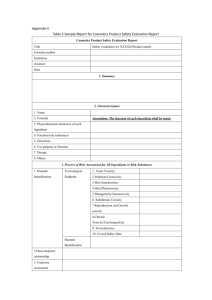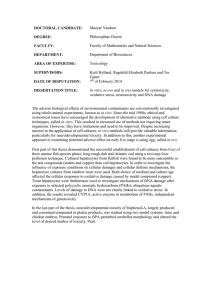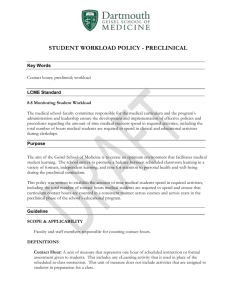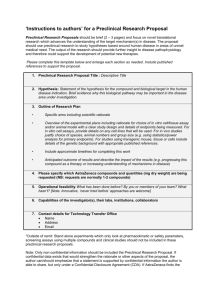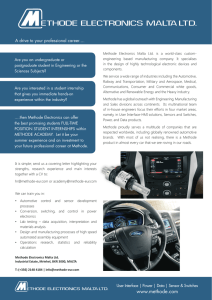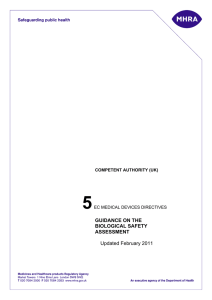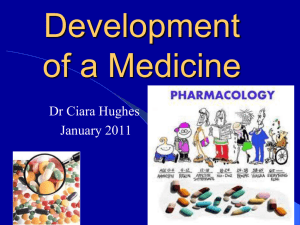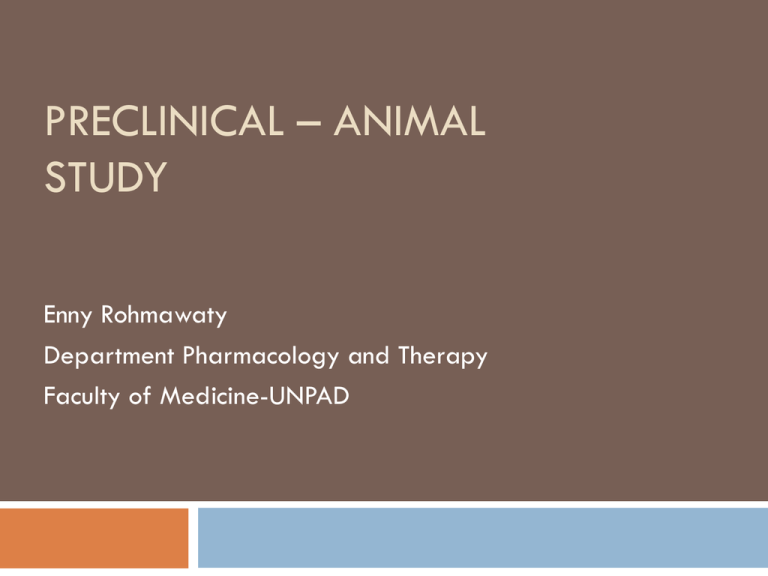
PRECLINICAL – ANIMAL
STUDY
Enny Rohmawaty
Department Pharmacology and Therapy
Faculty of Medicine-UNPAD
Preclinical study/preclinical trial
Preclinical trial - a laboratory test of a new drug
or a new medical device, usually done on animal
subjects, to see if the hoped-for treatment really
works and if it is safe to test on humans.
• Pre-Clinical Trials and Clinical Trials are the
processes by which scientists test drugs and
devices to see if they are SAFE and EFFECTIVE.
Experimental study
In vitro and in vivo
Animal models
Pharmacodynamic study
Toxicological study
• PHARMACODYNAMIC STUDIES
Effects / Efficacy
Mechanism of action
• TOXICOLOGICAL STUDIES
Safety
Spectrum
Pharmacodynamic study
In vitro: tissue, cell culture, blood component, etc
In vivo : whole animal
Disease model : inflammatory, dislipidemi, sepsis,
Ca/ malignancy, etc
Source of methode (literature) : Guidelines, journal
Methodology of pharmacodynamic
study
ANIMALS :
Rodent
or non-rodent (may depend on desired effect)
Healthy or diseased-animal model
Sex : male and/or female
Number : adequate for statistical analysis
Sample size determination:
Studies Comparing Two Group Means
To compute sample size for continuous variables, it is necessary to
obtain an estimate of the population standard deviation of the
variable (s) and the magnitude of the difference (d) the investigator
wishes to detect, often called the effect.
Sample size is given by
where s is the standard deviation, d is the difference to be detected,
and C is a constant dependent on the value of and selected. C can
be determined from the table above, which gives values for C for
two levels of and . Note that for 0.05 and 1- 0.9, C is 10.51 and
2C would be 21
Ralph B. Dell, Steve Holleran, R Ramakhakrishnan, Sample sice determination, 2002
Paired Studies
Paired studies compare values before and after an
intervention in the same animal. In this case, data
are analyzed by a paired t test, and the sample
size is computed by
Ralph B. Dell, Steve Holleran, R Ramakhakrishnan, Sample sice determination, 2002
If the s, d and C cannot be determined Federer’s
Formula
(t-1) (n-1) ≥ 15
t = number of treatment
n = number of sample
Federer WT. Experimental design, theory and application, 1967.
Data analysis
Program : SPSS
Normality and homogeneity test
Quantitative and Qualitative test
Post hoc analysis
Route of administration :
Per Oral- similar to human use
Dose :
Based on Dose-Response Relationship
One or more doses that provide a desired effect
Dose conversion from human to animal may be used
Calculation of ED50
Control group :
Negative control
Solvent / vehicle group
Positive control
Standard drug group
To validate that a method works
To obtain Relative Potency of drug candidate or herbal medicines
Toxicological studies
IN VIVO TOXICOLOGICAL STUDIES
A. GENERAL TESTS
SHORT TERM
Acute Toxicity Test (LD50)
LONG TERM:
Sub Acute Test
Sub Chronic Test
Chronic Test
B. LOCAL TOXICITY TEST
Dermatological Preparation
C. SPECIAL TOXICITY TESTS
Mutagenicity Test
Carcinogenicity Test
Reproductive and Development Toxicity Test
Animal models
Animal models are, at the best, analogous to
human condition but no theory can be provided
or refused by analogy. The truth is the evidence
in animals can be a powerful device in support of
virtually theory.
Basic Reason Using Animals For Research
Why are animals necessary in research?
1. Diseases process in human and animals have
similarities
2. Cell systems contain or manipulate only a part of
the organ system.
3. Computer models lack the complexities of living
entity .
WMA DECLARATION OF HELSINKI
(Tokyo 2004)
BASIC PRINCIPLES FOR ALL MEDICAL RESEARCH
- Medical research involving human subjects must
conform to generally accepted scientific principles,
be based on a thorough knowledge of the scientific
literature, other relevant sources of information, and
on adequate laboratory and, where appropriate,
animal experimentation.
- Appropriate caution must be exercised in the conduct
of research which may effect the environment, and
the welfare of animals used for research must be
respected
3R principles (Russell dan Burch, 1959)
R
R
R
eplacement
• Alternatifve methode
• lower class of animal model
eduction
• correct model
• genetic homogenity
• use healthy animal
efinement
• caring
• treatment
• non-invasive methode
• pain, stress, distress minimization
Five Freedoms = Animal welfare
“The council believes that the welfare of an animal ...
should be considered with reference to ‘Five
Freedoms’.
Freedom from hunger and thirst
Freedom from discomfort
Freedom from pain, injury and disease
Freedom to express normal behaviour
Freedom from fear and distress
(Farm Animal Welfare Council UK, 1993)
Group housing when
ever possible
Enrichment devices for
rodents: Igloo, nest etc.
Nesting materials
Human interactions
Enrichment Devices
for NHP
Natural Behavior of burrowing & hiding

